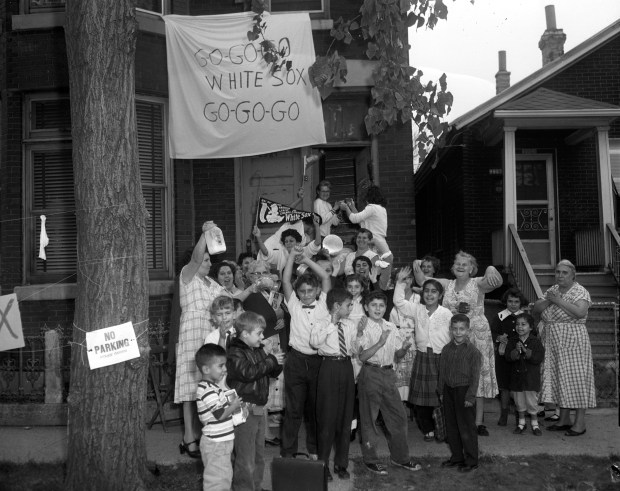Sitting in the office of then-Mayor and ever devoted White Sox fan Richard M. Daley, I heard him talk baseball. “I played all the time. Spring, summer and fall, we were always playing. I played catch with my dad … always in the backyard throwing the ball. And then, going to games, better than going to the movies. You knew all the players, all the averages and statistics. Baseball was king.”
Yes, it was.
For generations of us, baseball has been an ongoing novel, filled with sights and sounds and packed with disappointments and joys. There have been goats and black cats, bats juiced with cork, that lively Greek chorus known as sportswriters, owners, coaches, managers, umps, broadcasters, vendors, Andy Frain …
I’ve been a Sox fan for more than half a century. I had my eighth birthday party at Comiskey. I shook hand with Luis Aparicio and had lunch with Moose Skowron. And so with other fans I confront this season and the White Sox’s march toward (or trip down) to the record for the most losses in any major league baseball season.
That number is 120, held by the New York Mets in their first season in 1962, when they were called “lovable losers” in newspapers of the time. Though that phrase soon attached itself firmly to the Cubs and the Tribune featured this headline in 1982 — “Will the Cubs always be our lovable losers?” — the team answered that question and lost the tag with its 2016 World Series win.
But of the 1963 Mets team columnist Jimmy Breslin wrote, “The Mets are losers, just like nearly everybody else in life. This is a team for the cab driver who gets held up and the guy who loses out on a promotion because he didn’t maneuver himself to lunch with the boss enough. It is the team for every guy who has to get out of bed in the morning and go to work for short money on a job he does not like. And it is the team for every woman who looks up ten years later and sees her husband eating dinner in a T-shirt and wonders how the hell she ever let this guy talk her into getting married.”
This season’s Sox ineptitude has compelled everyone and their grandmother to chime in, to offer on TV and in print reasons for this “disaster,” and search for people to blame (players, manager, and, primarily, the boss, that increasing object of civic revulsion, Jerry Reinsdorf).
One new theory belongs to Grant DePorter. He is the CEO of Harry Caray’s Restaurant Group and a passionate baseball fan and historian.
A couple of years ago he and real estate developer Lee Golub discovered during renovations a time capsule that had been secreted into the Tribune Tower when it was built in 1925. Among its items was a baseball that he and experts determined was used in the 1919 World Series between the White Sox and the Cincinnati Reds.
“And it was a record-setting baseball,” he said at the time. “It is a baseball that struck out more batters in a row in a World Series than any baseball in history.”
That World Series resulted in what many consider the biggest scandal in the history of sports. The Black Sox Scandal, in short, involved eight members of the Sox being accused of throwing the series against the Cincinnati Reds in exchange for money from a group of gamblers.
This is what DePorter now says: “When the ball left the Tower and was put on display at the Chicago Sports Museum on Sept. 11, 2022, that was the day that the Sox shifted from being a winning team to a losing team.”
He happily cites all manner of won-lost statistics to prove his point and he is persuasive. “The ball, I am happy to say,” he says, “will be returned to the Tower this offseason and that should end this Curse of the Black Sox.”
Flashback: How 8 White Sox players fell from grace and were forever marked the Black Sox
Whatever the cause of this Sox skid, it’s odd, isn’t it, to celebrate failure? But think about it. This is a sport in which the best teams win only about 6 of every 10 games played. The best hitters fail at the plate roughly 7 times out of every 10. Little wonder that former White Sox manager Chuck Tanner (1970-75, record of 401 wins and 414 losses) once put it like this, “The greatest feeling in the world is to win a major league game. The second greatest feeling is to lose a major league game.”
In this fashion, baseball reflects life. It also, unlike basketball, football and hockey, is life-size and human. One does not have to be tall or large to play, or obscured and transformed with masks and padding. The players — most of them — look like you and me. And unlike other big city “games” such as politics, crime, business and culture, the rules and tools of baseball have remained relatively constant.
Dennis DeYoung, a native of the Roseland neighborhood, is a lifelong Sox fan.
I asked the founder of the rock group Styx about this current season. He sighed playfully and then drifted back, telling me, “The first time I saw Comiskey Park I was holding my dad’s hand as we climbed the stairs from the dark, dank lower concourse up to the field. I was nine. Cerulean blue skies mixed with near blinding sunlight illuminated the park making all colors seem unreal. The greenest grass I’d ever seen caressed the rich brown infield dirt, even the white baselines and batter box seemed to glow. It was like Dorothy going from black-and-white to technicolor when she opened the door and saw Oz. The aromas were an intoxicating amalgam of fresh grass, hot dogs, beer, popcorn and cigar smoke. I looked up at my dad and saw a big smile on his face. What a day.”

That’s the sort of powerful memory that can act as a comfort in hard times.
“I have friends and acquaintances involved in the organization, so it pains me for their sake and mine to witness this year,” says Deyoung. “To be a Sox fan and a South Sider comes with the knowledge that we’re second fiddle in this town. It’s a fact we don’t like but accept. We’re proud fans who love our team and heritage.
“Where this goes from here does not seem promising and is anybody’s guess. Sox fans know the team assembled this year is not populated with major league talent and any discussions otherwise are a smoke screen. What’s there to do? Beats me. I wish them all well, safe in the knowledge that no matter how hard they try, I will always have that day when a nine-year-old held his father’s hand.”
For their final three-game home series against the Los Angeles Angels that starts Tuesday, the team is touting a Fan Appreciation Series, with $10 tickets, $10 parking and “surprise giveaways.”
If the 120-loss mark is to be met or broken it might happen then and John Himmel might be there. He attended his first game while “in utero,” he says, more than 70 years ago. His mother Elinor was a devoted, even rabid, fan and he has been attending games every year since, with his daughters Charly and Gigi, and in recent years with his wife Kim.
Long the owner and operator of John Himmel Decorative Arts, he tells me, “Normally, we go to 12 to 15 games a year and watch on TV and listen on the radio. That’s been my team forever and I love the way it connects families through generations.

“This year has been so disappointing and, frankly, dull. In our daily lives most of us get ground down in ways large and small. In that way baseball reflects life. But there’s always next season. Hey, it’s baseball.”
Tom Weinberg is a broadcast documentarian best known for his PBS work (“Image Union,” “The 90s”). He is a lifelong Sox fan, and more, having been a minority owner during the time that Bill Veeck owned the team from 1959-1961 and 1975-1980. He taped many videos with Veeck and made a film about Sox great Minnie Miñoso, both available on his compelling archival site mediaburn.org.
“It’s not just this year, I have been disappointed for a long time,” he told me. “This particular record doesn’t bother me. It’s just a number. What bothers me is the systematic failure of this organization from top to bottom. It’s a slap in the face of the whole city, of all fans. It’s all about money with Reinsdorf, not about the love of the game. And I love this game.”
It is no longer our national pastime, slowly but inexorably losing that claim to football and basketball. But there is something wonderfully communal about rooting for a team. It is a shared passion that can bind strangers, and one that transcends race, religion and gender. When your team wins, it is a shot in the arm to your self-esteem. When it loses there is a loss of self-esteem. And we carry on. Think spring.
rkogan@chicagotribune.com



